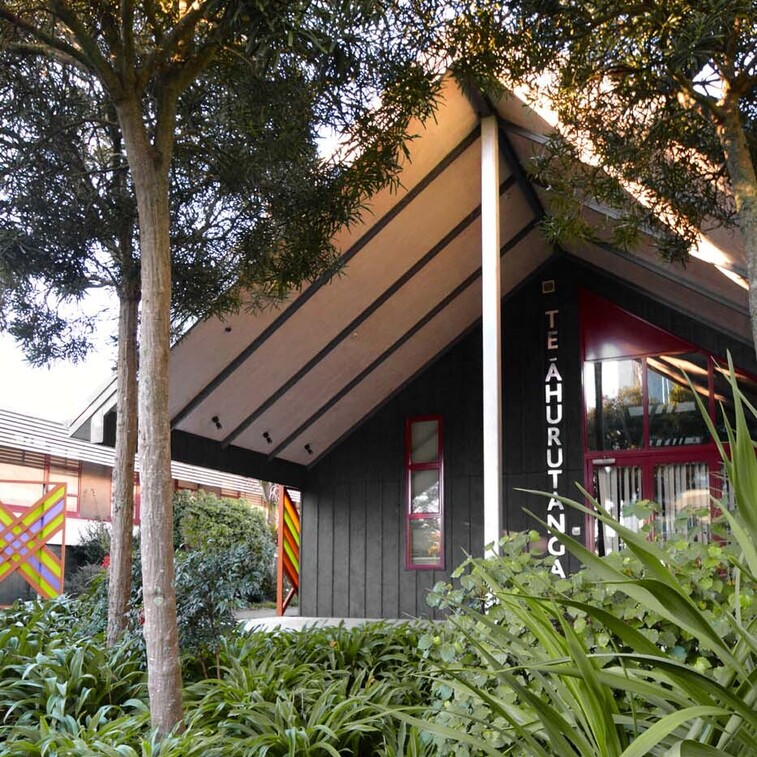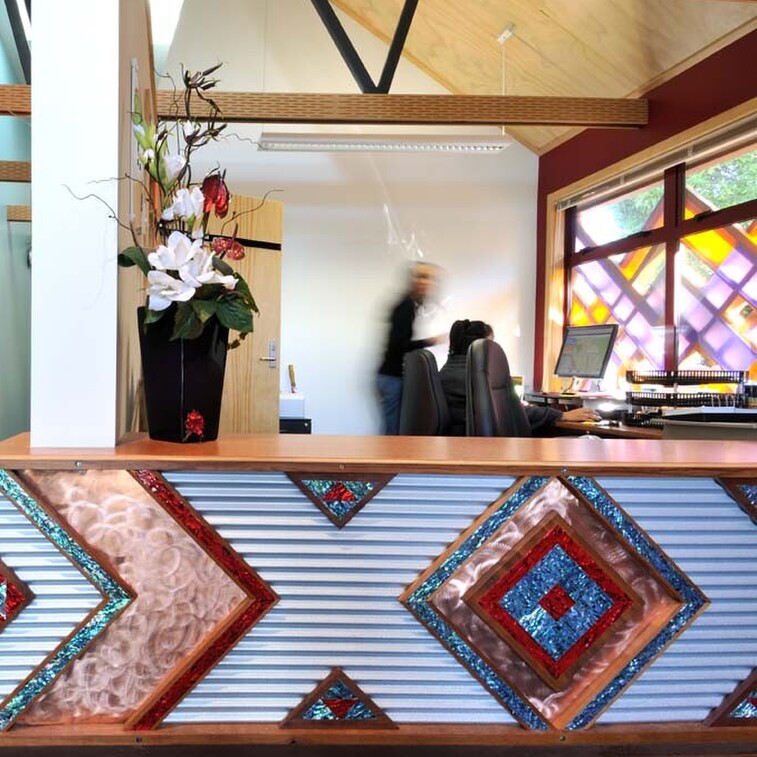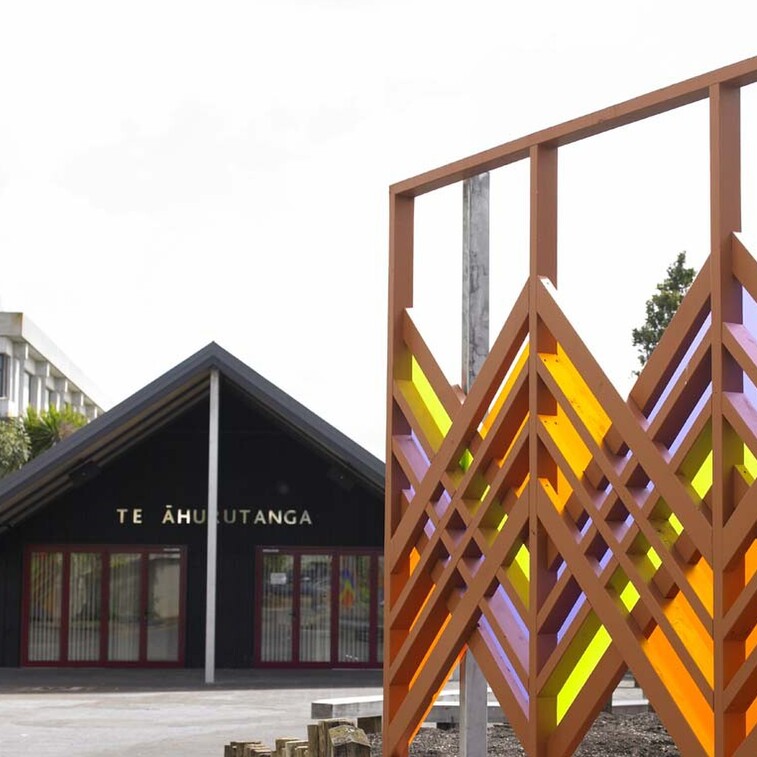Te Āhurutanga
The University of Waikato, Hamilton
Te Āhurutanga is in a class of its own on the Waikato University campus. The single-storey cedar building with its steeply pitched roof and deep verandas has the unmistakable air of a Māori whare, and it stands proud and colourful among the neighbouring buildings. Te Āhurutanga has recently begun a new chapter in its campus history and it has a new look to complement the change of status, a look that weaves together its past and present roles and offers a creative environment for those who work there.
Te Āhurutanga's name embraces concepts of “sheltered haven, calm and protected surroundings, a place to gather strength from each other”, and it was opened in 1988 as a support and study space for students from the university's rapidly growing Māori Department. It fulfilled that role handsomely but last year it became the office of the Pro Vice-Chancellor Māori, Professor Linda Tuhiwai Smith.
The brief called for the renovation of the existing building to provide a new facility for the Māori Executive team. The design contemplates the concepts evident in traditional Māori architecture as a way of creating identity for the faculty. The undoubtedly contemporary interior provides an interplay of texture, shape and light throughout, with spaces arranged around a central hall that promotes both connection and conversation.
Completed 2007
Architect Richard Mauriohooho, of Hamilton practice Antanas Procuta Architects (now PAUA), has had the job of turning the plain-but-functional 1980s-style building into a warm, vibrant new working space with a deliberate expression of Māori architecture for Professor Smith and her staff, who provide executive leadership in supporting the university to meet its commitments to Māori students, staff and communities.
Achieving such a transformation with Te Āhurutanga has been a “challenging and interesting journey,” Mauriohooho says. As a Māori architect, Mauriohooho is familiar both personally and professionally with traditional Māori architecture, and with Te Āhurutanga he wanted to introduce a more contemporary, imaginative interpretation with the traditional concepts within the constraints of the project budget and location.
As he takes a tour of the building, Mauriohooho points out the subtle and singular ways Te Āhurutanga has become a stunning new place at the old address. Previously, Te Āhurutanga turned its back on its warm north side facing the university library. This area has now been opened up to offer a welcoming entrance with a sunny mahau (verandah), and visitors step into a small reception area glowing with colour, light and artwork. On the south end, extra space has been cribbed from the original south mahau, now enclosed to form a comfortable meeting area and staff room. A new southern mahau opens to the broad Tainui Courtyard, and this has been redeveloped in tandem with Te Āhurutanga's renovations. It can be used for outdoor functions.
Mauriohooho has used shape, form, texture and light to achieve a warm, spacious feeling throughout Te Āhurutanga. Previously, the low ceilings produced a cramped atmosphere, and these have been lifted to expose the rafters and trusses, as in a traditional whare. Horizontal truss members have been clad with multi-groove textured linings to replicate woven bindings used in whare.
“Stripping out the old ceiling has transformed Te Āhurutanga, and opened it up,” Mauriohooho says, as he points to the soaring roofline. “We have exposed the bones of the building, installed new skylights, and angled back the hall walls at the upper level to provide a light-filled, airy, warm transition space linking the offices.”
The hall is now the core of the building: It is painted in strong colours of seafoam and pohutukawa and has superb natural light and interesting angles; it makes a seamless connection between the functional rooms (administration, storage, ablutions, kitchen) on one side and staff offices on the other. In another design device, Mauriohooho has stepped the corners of each office out into the hallway, providing a subtle sense of movement and transition.
Mellow New Zealand radiata pine plywood has been used throughout the interior ceilings, while radiata pine has also been used for the interior doors and trim. An intentional use of local materials, commitment to energy conservation, use of recycled materials, over insulation, double glazing, and exterior screens have contributed to Te Āhurutanga achieving a good Green Star Environmental rating.
Stunning contemporary artwork by James Webster was commissioned for the project. Webster's panels also offer a contemporary interpretation on traditional Māori artwork, in keeping with Te Āhurutanga's new look and purpose. They are constructed with baby corrugated iron, recycled copper and paua laminate with native timber framing, and each tells a story linked to education themes. Webster's artwork is placed at each of the steps in the hall walls, providing a feeling of regular pou as seen in a traditional whare.
There is more colour, texture and contemporary appeal outdoors where rainbow-coloured “woven” screens draw the eye: Mauriohooho has placed these exterior screens adjacent to the windows, and they are reminiscent of traditional woven tukutuku panels. Constructed from timber and brilliantly coloured perspex, they are decorative as well as functional; they offer privacy, filter the morning sun and western light, and add to Te Āhurutanga's distinctive new charm. “On a sunny day, you observe wonderful patterns of light washing through the perspex screens, which give the appearance of a stained glass window,” Mauriohooho says.
The proof of success for the transformation, of course, lies in the hands of those who use the building every day: Professor Linda Smith praises the result: “Te Āhurutanga is a distinctive building on the university landscape, and now it is refurbished it stands as a very smart, modern and functional facility.”
Professor Smith says Te Āhurutanga is not a new building and in the past 20 years, it has seen and heard many diverse kaupapa on its courtyard and within its walls: “Those stories are part of the heritage of the institution. I am hopeful the work of my office will complement and enhance the original kaupapa of Te Āhurutanga - to support staff and student communities of the university.”
Herearoha Skipper, Manager of Project and Resource for the office, describes Te Āhurutanga as an inspirational environment: “Everybody enjoys coming to work, it's like our home, and we like to bring whānau and friends here to visit. We're really rapt with the way it turned out.”
John Cameron, the university's Director of Facilities Management, says the refurbishment has shown what can be done with a rather simple building by using imaginative design, and Te Āhurutanga has a strong sense of place on campus. Cameron says the university extended the project budget but the outcome far out-weighs the extra cost. “It was worth it.”
Trevor Harris, Buildings Maintenance Manager, says the Te Āhurutanga project called for flair, imagination and sensitivity. “The resulting renovations continue to win the praise of visitors and staff alike – not least the users of the building - and Antanas Procuta Architects can be proud of what they have helped achieve.”
For his part, Mauriohooho says, “it's been a great job, a little gem, a chance to push ideas and create a nice environment”.
Te Āhurutanga Whare
Artwork panels (descriptions by artist James Webster)
‘He mahi toi. He mana tangata.’
These panels have been constructed of modern materials; being baby corrugated iron, copper and paua laminate with native timber edging.
These materials were chosen to complement the newly renovated, modern look of the Te Āhurutanga building. The patterns used are based on traditional Māori patterns.
Reception desk panel: ‘Patikitiki’
The central pattern is based on the Patikitiki design. The design itself, which is based on the flounder fish, indicates favourable harvests and abundant food, good weather and favourable times.
1st vertical panel: ‘Poutama’
The main pattern featured in this panel is the Poutama pattern. The Poutama, or steps, pattern has religious and educational connotations. The steps relate to levels of attainment and advancement.
2nd vertical panel: ‘Arapiki’
Ara = pathway. Piki = climb, ascend.
This panel denotes a striving and persistence in the pursuits of education and knowledge.
3rd vertical panel: ‘Aratika’
Ara = pathway. Tika = straight, direct, right, correct
This panel denotes a direct path to obtaining knowledge.
4th vertical panel: ‘Taratara-a-kai’
This is a pattern used extensively in the decoration of pataka (storehouses). This panel represents the accumulation of kai (food) knowledge acquired through education.
The colours used for these panels also have symbolic reference:
The silver of the baby corrugated iron equates to Te Marama (the moon), feminine principle or ira wahine.
The copper colouring equates to Te Rā (the sun), masculine principle or ira tāne.
The red represents the taha kikokiko, our physical side.
The blue represents the taha hinengaro, our mental capacity and emotions.
The native timber framing is likened to Tāne Whakapiripiri and represents the conjoining of life.
I hope these explanations will give the viewer an insight into the symbolic representations conveyed in the artwork panels displayed in the building, Te Āhurutanga, and their corresponding references to education.
Mauri ora na James Webster











